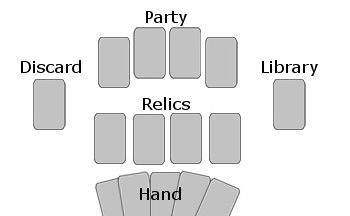I am eager to share with everyone some of the current plans for Crea’s gameplay. What you will be reading has seen dozens of revisions, both minor and major, and will likely see a few more eventually. I may at a later date go into some detail on the design decisions that have been made, but without further ado here is the Match gameplay for Crea.
Match
In Crea, the core gameplay is a match between two opposing players or teams. Each player has a party of four character cards and a deck composed of a minimum of 60 cards with no more than four instance of a card. Each character has a given amount of hit points (HP). A team has won once they have depleted the opposing team’s characters of all HP.
Each player begins the match with eight cards in hand, drawn from their library, and all four characters laid out in front of them face up. Every character starts the match channeling a powerful being known as an Aer. There are many Aers that a character can channel, and each has unique cards that only characters channeling that Aer can use.
A round is split into three phases: Draw, Channel, and Action.
- During the Draw phase, each player draws two cards from their library.
- During the Channel phase, a player has the choice to shift which Aer each character is channeling. The Aer a character is channeling is known as the active Aer. A character is limited to the two Aers chosen prior to the match, and shifting has a cooldown time of two rounds.
- During the Action phase, players take turns being the active player alternating teams and players. The active player can play as many cards from their hand as long as they meet the card’s requirements. This is either blessing a character with an Ability, equipping a character with Equipment, or having a having a character use a Relic. The active player can have a single character perform an action from either one of the abilities it has been blessed with or a Relic in play. The active player also has the choice to pass on taking the action. In either case afterwards the next player becomes the active player. When a character performs an action the opposing team is given the chance to react to this action. Once each player is given the chance to be the active player four times the action phase ends.
Round Example
Here is an example of a round where Player A and Player B are matched up against each other. The first active player is randomly decided at the start of the match and then alternates each round.
- Draw phase. Player A and Player B both draw two cards.
- Channel phase. Players choose to change the active Aer for each of their characters, unless the character is on cooldown from recently changing their Aer.
- Player A is the active player.
- Player A looks over their hand and blesses, equips, or uses any cards that their characters meet the requirements.
- After getting their party set up Player A is able to use any one ability.
- Player B is able to use any of their reactive abilities to counter Player A’s action.
- Player A’s turn is over, and now Player B is the active player.
- Player B goes through all the same steps as Player A did before.
- Once both players go through these steps four times the round is over.

